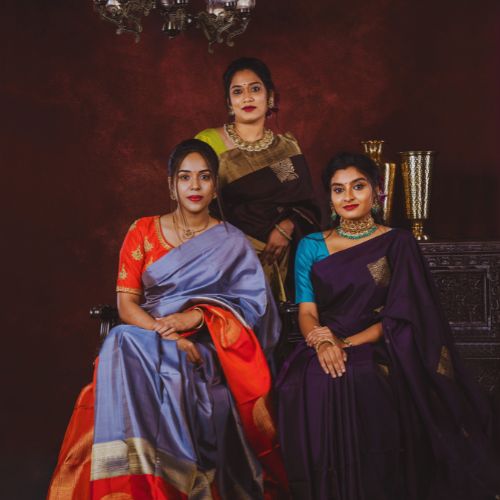Can You Wear a Silk Saree Without a Petticoat? Draping Hacks & Styling Freedom
The saree has long been seen as a symbol of grace, tradition, and timeless beauty. For many, it’s synonymous with a blouse and petticoat. But what if we told you that this wasn’t always the case?
Before the British colonial influence, the saree was draped in a multitude of ways—fluid, functional, and often worn without either a blouse or a petticoat. Today, as modern women revisit cultural roots and embrace both comfort and authenticity, the question is back on the table:
Can you wear a silk saree without a petticoat?
Yes, you can. And also let’s rewind for a moment and understand why we even started wearing petticoats in the first place.
A Brief History: The Saree Before the British Raj
Historically, sarees were worn without any underskirts or blouses. The garment was a complete ensemble by itself—draped strategically to cover the body, sometimes exposing the midriff, shoulders, or even the chest, depending on the region and purpose. This was the style for centuries in pre-colonial India, especially in rural or less-restricted urban settings.
However, during the Victorian era, modesty codes began to influence Indian dress. The British, with their conservative ideals, saw the traditional saree as ‘improper’ without a blouse or petticoat. In response to colonial discomfort, blouses and petticoats were introduced and even encouraged through dress reform. Petticoats became the structured base to which the saree could be tucked and secured—an idea that slowly became standard.
Even today, we see this influence. Most women instinctively reach for a petticoat while draping a saree. But it’s important to remember: none of India’s original regional drapes required a petticoat. And many didn’t need a blouse either.
The Saree is More Versatile Than You Think
You’ve likely seen the elegant Nivi drape (popularised in Andhra Pradesh), but did you know there are over a hundred ways to drape a saree across India? From the Kodagu style in Karnataka to the Madisar in Tamil Nadu, from the Nauvari in Maharashtra to the tribal drapes of Odisha—each style emerged from climate, culture, lifestyle, and ease.
In many of these styles, the saree is wrapped directly around the body or paired with alternative bottoms—dhoti-style, pant-style, or even without any innerwear. The saree wasn’t about restriction; it was about flow, function, and freedom.
Here are a few traditional drapes that doesn’t require a petticoat:
• Nauvari (Maharashtra) – A traditional drape that involves wrapping the saree around the body like a dhoti. The saree is tucked between the legs and around the waist, giving you the freedom of movement without the need for a petticoat.
• Madisar (Tamil Nadu) – This drape, popular in the Tamil Brahmin community, uses a pleated technique to secure the saree firmly. No petticoat is needed here either, especially when it’s worn with a snug blouse.
• Seedha Pallu (Gujarat) – Another classic style, where the saree’s pallu is draped over the left shoulder, and the pleats are neatly tucked in front. A petticoat isn’t essential in this traditional Gujarati drape.
The idea was to keep things fluid and functional—something that’s often lost in our modern-day interpretation of the saree.
Do You Have to Wear a Petticoat with a Silk Saree?
Yes, you can wear a silk saree without a petticoat, especially when embracing alternative draping methods that prioritize comfort and style. In modern saree styling, many opt for fusion drapes that enhance mobility and elegance.
Traditional Saree Drapes That Skip the Petticoat. Whether it’s a destination wedding, a stylish pre-wedding event, a photoshoot, or just a day where you want to feel a little lighter, without wearing petticoat, it can be done well.
If you’ve ever worn a silk saree without a petticoat, you know how freeing it can feel. The fabric falls more naturally, and you get to embrace the authentic drape styles that have existed for centuries.
Top Alternatives to Petticoats for Sarees
If you want to try going petticoat-free, here are some modern alternatives that work just as well—if not better.
1. Saree Shapewear
This one’s a wardrobe essential in the modern saree world. Shapewear not only replaces your petticoat, it enhances your silhouette, hugs your curves, and stays snug without slipping. It’s breathable, stretchable, and easy to drape over.
Shapewear is tailored to fit the body and prevents the saree from bunching or shifting, making it a great option for those who prefer a more fitted look.
2. Leggings or Tights
For lighter sarees or more casual wear, high-waisted leggings are a great pick. They're comfortable, grip well at the waist, and give a streamlined look underneath. Choose seamless ones to avoid lines.
Leggings or tights are quick and easy, and they are ideal for a chic, minimalist look. They don’t interfere with the draping process and allow the saree to flow without any cumbersome structure.
3. Dhoti Pants or Palazzos
For those who love a bit of drama and experimentation! Drape your saree over dhoti pants or palazzos to get an Indo-western, fluid look. It’s breezy, stylish, and often doesn’t even look like you’ve skipped the petticoat.
The draped pants provide ample coverage and room for movement, making this a more comfortable and modern alternative to traditional draping.
4. Draped Skirts or Pre-stitched Bases
These are ready-to-wear underskirts, often with stitched pleats or draped folds, that offer the look of a saree with the ease of a skirt. Tuck your saree into one and get the elegance without the layers.
Pre-stitched saree skirts are easy to wear, eliminate the need for constant tucking, and provide a snug fit that ensures your saree stays in place.
Modern Saree Draping Hacks Without Petticoats
Modern saree draping empowers you to wear a silk saree without a petticoat by choosing chic and functional alternatives like saree shapewear, dhoti pants, or seamless leggings. Here’s how to keep your saree secure, stylish, and effortlessly graceful throughout the day:
Pin Strategically
You don’t need a dozen pins. In fact, traditional saree drapes used no pins at all! Use just one or two at the shoulder or waist for extra grip, too many pins can actually weigh the saree down and reduce its fluidity.
Secure the Tuck
If you’re using leggings or shapewear, make sure the waist is snug. Tuck the saree evenly and neatly across the front. For added security, use a drawstring or elastic waistband.
Play with Draping Styles
Explore regional drapes that naturally don’t require a petticoat. The Nauvari (Maharashtra), Seedha Pallu (Gujarat), and even the Madisar (Tamil Nadu) can be adapted beautifully with modern styling.
Choose the Best Silk Fabric for Easy Draping
When opting to wear a silk saree without a petticoat, fabric choice makes a big difference. Textured silks like tussar, raw silk, and silk-cotton provide a natural grip, making them ideal for secure, petticoat-free draping. On the other hand, smoother fabrics such as tissue silk or satin-finish silk can be slippery—so style them with care and secure with minimal, strategic pinning to maintain elegance and flow.
Final Word: Your Saree, Your Style
The saree has never been about rigid rules. It’s about freedom, About movement, About expressing who you are, on any given day. And sometimes, that means wearing it without a petticoat. And that’s absolutely okay.
With thoughtful draping, clever styling, and the right fabrics, you can wear your silk saree comfortably, gracefully, and authentically—just like it’s meant to be.
At JP Silks, we celebrate every way you choose to wear a saree—be it traditional drapes, modern petticoat-free styles, or bold fusion looks. Whether you're embracing a classic silk saree without a petticoat or experimenting with contemporary draping techniques, it's all about comfort, confidence, and authentic expression. Explore our collection of silk sarees designed for every draping style and redefine elegance—your way.
FAQs
1. Can I wear a silk saree without a petticoat?
Yes, you can wear a silk saree without a petticoat by opting for alternatives like saree shapewear, leggings, or dhoti pants. These options provide comfort and support while allowing for a modern twist on traditional draping.
2. What are the best alternatives to a petticoat for sarees?
Alternatives to traditional petticoats include saree shapewear, leggings, dhoti pants, palazzos, and pre-stitched saree skirts. These options offer flexibility and can enhance the overall look of your saree.
3. Which silk fabrics are ideal for draping without a petticoat?
Silk fabrics like tussar, raw silk, and silk-cotton blends have a natural texture that helps them stay in place, making them suitable for draping without a petticoat. However, smoother silks like tissue or satin-finish may require additional pinning.
4. Are there traditional saree styles that don’t require a petticoat?
Yes, traditional styles such as the Nauvari (Maharashtra), Madisar (Tamil Nadu), and Andhra Puja drapes are traditionally worn without a petticoat. These styles are rooted in cultural practices and offer unique draping techniques.
5. Is it appropriate to wear a saree without a petticoat to formal events?
Absolutely. Wearing a saree without a petticoat can be both elegant and appropriate for formal occasions, provided the draping is neat and the alternative base wear complements the saree's fabric and design.


